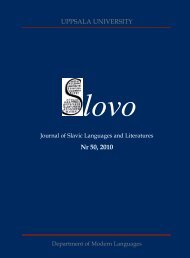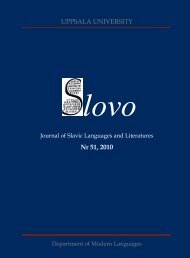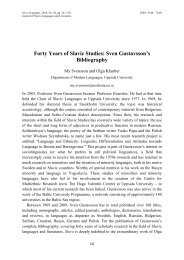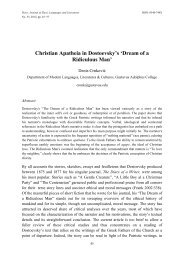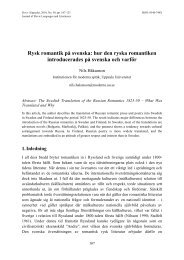Full text PDF - Index of - Uppsala universitet
Full text PDF - Index of - Uppsala universitet
Full text PDF - Index of - Uppsala universitet
Create successful ePaper yourself
Turn your PDF publications into a flip-book with our unique Google optimized e-Paper software.
Slovo.<br />
Journal <strong>of</strong> Slavic Languages and Literatures<br />
However, under byvalo a forward shift makes little sense semantically, since we are<br />
quantifying over subintervals t <strong>of</strong> the habitus. Furthermore, there is no reason to<br />
assume that the con<strong>text</strong>ually provided subintervals t would be minimal intervals (i.e.,<br />
points in time). Accordingly, the natural interpretation is the non-coerced “present<br />
perfective”: e t, where t is identical to the subintervals provided by the habitual<br />
quantifier and the con<strong>text</strong>. The local reference time t – the “lower tense” – is therefore<br />
neither forward shifted with respect to the habitus nor forward shifted with respect to<br />
the con<strong>text</strong>ually given subintervals <strong>of</strong> the habitus. The present tense morphology is<br />
simply a reflex <strong>of</strong> a bound and tenseless form – bound by the con<strong>text</strong>ually relevant<br />
subintervals induced by byvalo. The morphological present tense feature [un] in<br />
“uvidit” and “načnet” in example (45) must therefore be licensed by the [in] feature<br />
which comes along with semantically tenseless propositions in Russian.<br />
In this respect there is no temporal difference between the perfective verbs uvidit<br />
and načnet on the one hand and the imperfective mašet on the other in this particular<br />
environment (under byvalo). The aspectual difference in example (45) can then be<br />
reduced to a truly aspectual (Aktionsarten) opposition: the perfective punctual<br />
achievements uvidit i načnet versus the imperfective activity predicate mašet rukami.<br />
8. Open ends: from habituals to implicatives<br />
The present article is motivated by the idea <strong>of</strong> extending the SOT parameter to “new”<br />
data. Along the way I have also made some comments on the role <strong>of</strong> aspect in the<br />
constructions under consideration. However, the analysis <strong>of</strong> aspect is strictly speaking<br />
not essential to the plot.<br />
An issue that has not been covered here is whether the analysis <strong>of</strong> habituals should<br />
be modalized. Owing to the “imperfective paradox” we need a modal operator in the<br />
lower aspect when we have a progressive interpretation (the event is located at a<br />
superinterval <strong>of</strong> the con<strong>text</strong>ually given local reference time, and therefore we don’t<br />
know whether the event is “completed” in the actual world). Similarly, the habitus<br />
(higher aspect) is also imperfective in that it is located at a superinterval <strong>of</strong> the<br />
“higher” reference time. In habituals we do not necessarily know how many – if any<br />
(?) – VP-events are actually instantiated in the actual world.<br />
Ideally, one would furthermore like to explain the cross-linguistic parallels between<br />
habituality and counterfactuality 15 (and imperfective marking), or the simple<br />
observation that English uses the verbal quantifier would in both counterfactuals and<br />
habituals. 16<br />
15 Note that the phenomenon <strong>of</strong> “fake tense” in counterfactuals is different from “zero tense” in complements<br />
under attitudes and byvalo, cf. (Grønn & von Stechow 2010).<br />
16 A parallel perhaps worth exploring further is the following: in counterfactual constructions the operator<br />
“would” is typically modified by a semantically tenseless if-clause, while the habitual operator (“would”/“used<br />
76



